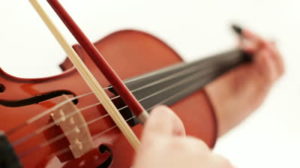Do you ever wonder how to convey the entire dynamic and tone ranges seen in music? From forte to mezzo piano to fortissimo, dynamics can change quickly and sporadically throughout pieces, which can be challenging to truly convey. Additionally, gradual volume or sound changes written in music such as crescendos and decrescendos can be difficult to illustrate at the appropriate time in phrases.
LUCKILY there are 3 techniques every stringed musician can do that will allow you to change the sound you are producing on your instrument; violinists, violists, cellists and bassists can all utilize and use these techniques. Once you’re aware of these 3 “tricks,” you’ll be able to easily fluctuate and create diverse volumes, tones and musical characters on your instrument.
1. BOW SPEED
“Bow speed” refers to how fast or slow you move and the speed in which you allow your bow to travel on each string. How fast your bow moves will determine different vibrations of the strings and produce different dynamic tones. The faster you move your bow, especially when changing its direction, will naturally cause an increase in volume. As you slow down your bow, volume will usually decrease, as the weight of your arm will simultaneously lessen. For example, if you’re having difficulty creating an exciting and noticeable crescendo, check into the speed of your bow! I guarantee that you will be able to make this gradual increase of volume as you gradually increase your bow speed.
2. CONTACT POINT ON THE STRINGS
Depending on where you place the bow and play between the bridge and fingerboard, you can produce a vast array of colors in your music. Remember that playing closer to the bridge increases the distance to your finger on the fingerboard. This increased length of string allows the string to have more room to vibrate, creating a brighter and louder sound. The opposite is true when you play closer to the fingerboard: the length of string becomes smaller and vibrates less. For example, if you were trying to create a pianissimo dynamic, you would be able to do so very easily if you moved the bow closer to the fingerboard and played slightly farther away from the bridge.
3. BOW WEIGHT ON THE STRINGS
“Bow weight” can be tricky because it can be misinterpreted as the “pressure” we put on the string, but pressure uses tension and we want to avoid that! So what is arm or bow weight and how do we use it? Applying this type of weight requires relaxation. While placing the bow on the string, feel your bow hand relax into the string, knuckles flattening down on the stick, and you should be able to start to feel this “hair to string” weight. Let gravity take its toll (which is tension-less) and feel the weight sink “into” the string as you place different parts of the bow on it. Once you’ve experimented with this technique, you will be able to use arm weight intelligently and it will help you create a variety of dynamics that will bring phrasing and musicality alive in your music.
I hope these tips and tricks will help you create any sound you are looking for. When combining all three of these techniques, you will be able to generate all levels of tone production and sound!
Related Articles
“Breaking the Classical Stereotype” by Freeway Music Violin Instructor Zoe Whittaker

